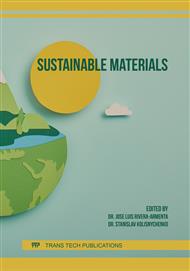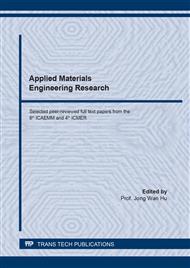[1]
X. Li, S. Deng, H. Fu, T. Li, Adsorption and inhibition effect of 6-benzylaminopurine on cold rolled steel in 1.0 M HCl, Electrochim. Acta. 54 (2009) 4089-4098.
DOI: 10.1016/j.electacta.2009.02.084
Google Scholar
[2]
I.A. Zaafarany, Corrosion Inhibition of mild steel in hydrochloric acid solution using cationic surfactant olyel-amido derivatives, Int. J. Elect. Sci. 8 (2018) 9531–9542.
Google Scholar
[3]
P.R. Knowles, Design of structural steelwork. London: Surrey University Press, 1987, p.1.
Google Scholar
[4]
G.S. Brady, H.R. Clauser, J.A. Vaccari, Materials Handbook. New York: McGraw-Hill, (2002).
Google Scholar
[5]
H. Ludwig, Waterside scaling, deposition and corrosion in steam generators, TÜV SÜD Group, 2005. Available online at http: //www.sme %20Scaling%20 Deposition%20and%20Corrosion% 20in%20Steam%20Generators.pdf.gtz.org.vn/Portals/0/AnPham/Waterside.[Accessed: 27/01/2019].
Google Scholar
[6]
P. Mayer, H.J. Westwood, A.V. Manolescu, Corrosion related problems in fossil fired boilers, J. Mater. Environ. Sci. 2(1) (1990) 55–64.
DOI: 10.1007/bf02833398
Google Scholar
[7]
H. Ashassi-Sorkhabi, M.R. Majidi, K. Seyyedi, Investigation of inhibitive action of amino acids against steel corrosion in HCl solution, Appl. Surf. Sci. 225 (2004) 176-185.
DOI: 10.1016/j.apsusc.2003.10.007
Google Scholar
[8]
A.Y. El-Etre, Inhibition of aluminum corrosion using opuntia extract, Corros. Sci. 45 (2003) 2485-2495.
DOI: 10.1016/s0010-938x(03)00066-0
Google Scholar
[9]
A.Y. El-Etre, Natural honey as corrosion inhibitor for metals and alloys. I. Copper in neutral aqueous solution, Corros. Sci. 40 (1998) 1845-1850.
DOI: 10.1016/s0010-938x(98)00082-1
Google Scholar
[10]
C.A. Loto, R.T. Loto, A.P.I. Popoola, Electrode potential monitoring of effect of plants extracts addition on the electrochemical corrosion behaviour of mild steel reinforcement in concrete, Int. J. Elect. Sci. 6(8) (2011) 3452-3465.
Google Scholar
[11]
R.T. Loto, Electrochemical analysis of the corrosion inhibition properties of 4-hydroxy-3-methoxybenzaldehyde on low carbon steel in dilute acid media, Cogent Eng. 3(1) (2016) 1242107.
DOI: 10.1080/23311916.2016.1242107
Google Scholar
[12]
I.B. Obot, N.O. Obi-Egbedi, Inhibitory effect and adsorption characteristics of 2, 3-diaminonaphthalene at aluminum/hydrochloric acid interface: Experimental and theoretical, Surf. Rev. Lett. 15(6) (2008) 903. doi.org/10.1142/S0218625X08012074.
DOI: 10.1142/s0218625x08012074
Google Scholar
[13]
I.B. Obot, N.O. Obi-Egbedi, S.A. Umoren, E.E. Ebenso, Synergistic and antagonistic effects of anions and ipomoea invulcrata as green corrosion inhibitor for aluminium dissolution in acidic medium, Int. J. Elect. Sci. 5 (2010) 994-1007.
Google Scholar
[14]
SM.A. Shibli, V. Anitha Kumary, Inhibitive effect of cacium gluconate sodium molybdate on carbon steel, Anti-Corros. Method M. 51 (2004)277-281.
DOI: 10.1108/00035590410541355
Google Scholar
[15]
I.B. Sing, G. Venkatachari, K. Balakrishnan, Inhibition effect of sodium boro-gluconate on mild steel with and without nitrite ions in low chloride containing water, J. Appl. Electrochem. 24 (1993) 179-183.
DOI: 10.1007/bf00247790
Google Scholar
[16]
S. Rajendran, B.V. Apparao, N. Palaniswamy, Technical note calciofon as corrosion inhibitor for mild steel in low chloride media, Br. Corros. J. 33(4) (1998) 315-317.
DOI: 10.1179/bcj.1998.33.4.315
Google Scholar
[17]
M. Saremi, N. Parsi Benehkohal, C. Dehghanian, H.R. Zebardast, Effect of calciofon concentration and hydrodynamic effect on mild steel corrosion inhibition in simulated cooling water. Corrosion, 65(12) (2009) 778-784. doi.org/10.5006/1.3319104.
DOI: 10.5006/1.3319104
Google Scholar
[18]
S. Karim, C.M. Mustafa, Md. Asaduzzaman, M. Islam, Corrosion inhibition of mild steel by calciofon in simulated cooling water. Leonardo El. J. Pract. Technol. 9(16) (2010). http://lejpt.academicdirect.org/A16/167_176.htm.
Google Scholar
[19]
R.T. Loto, E. Oghenerukewe, Inhibition studies of rosmarinus officinalis on the pitting corrosion resistance 439L ferritic stainless steel in dilute sulphuric acid, Orient. J Chem. 32(5) (2016) 2813–2832.
DOI: 10.13005/ojc/320557
Google Scholar
[20]
R.T. Loto, Corrosion inhibition performance of the synergistic effect of rosmarinus officinalis and 5-bromovanillin on 1018 carbon steel in dilute acid media, J. Fail. Anal. Prev. 17(5)(2017)1031-43.
DOI: 10.1007/s11668-017-0334-z
Google Scholar
[21]
K. Xhanari, M. Finšgar, M.K. Hrncica, U. Maver, Z. Knez, B. Seiti, Green corrosion inhibitors for aluminium and its alloys: A review, RSC Adv. 7(44) (2017) 27299–27330.
DOI: 10.1039/c7ra03944a
Google Scholar
[22]
J.C. Chalchat, R.P. Garry, A. Michet, B. Benjilali, J.L. Chabart, Essential oils of rosemary (Rosmarinus officinalis L.). The chemical composition of oils of various origins (Morocco, Spain, France), J. Essent. Oil Res. 5(6) (1993) 613–618.
DOI: 10.1080/10412905.1993.9698293
Google Scholar
[23]
R.T. Loto, O. Olowoyo, Corrosion inhibition properties of the combined admixture of essential oil extracts on mild steel in the presence of SO42− anions, South Afr. J. Chem. Eng. 26 (2018) 35–41.
DOI: 10.1016/j.sajce.2018.09.002
Google Scholar
[24]
R.T. Loto, R. Leramo, B. Oyebade, Synergistic combination effect of salvia officinalis and lavandula officinalis on the corrosion inhibition of low-carbon steel in the presence of SO42- and Cl- containing aqueous environment, J. Fail. Anal. Prev. (2018) 1-10. doi.org/10.1007/s11668-018-0535-0.
DOI: 10.1007/s11668-018-0535-0
Google Scholar
[25]
R.T. Loto, Comparative assessment of the synergistic combination of ricinus communis and rosmarinus officinalis on high-carbon and P4 low-carbon mold steel corrosions in dilute acid media. J. Bio Tribo Corros. 4(47) (2018). doi.org/10.1007/s40735-018-0163-y.
DOI: 10.1007/s40735-018-0163-y
Google Scholar
[26]
G. Cristofari, M. Znini, L. Majidi, A. Bouyanzer, S.S. Al-Deyab, J. Paolini, B. Hammoutim, J. Costa, Chemical composition and anti-corrosive activity of pulicaria mauritanica essential oil against the corrosion of mild steel in 0.5 M H2SO4, Int. J. Elect. Sci. 6 (2011) 6699-6717.
DOI: 10.1016/j.lwt.2013.05.030
Google Scholar
[27]
P. Bommersbach, C. Dummont-Alemany, J.P. Millet, B. Normand, Hydrodynamic effect on the behaviour of a corrosion inhibitor film: Characterization by electrochemical impedance spectroscopy, Electrochim. Acta 51(19) (2006) 4011-4018.
DOI: 10.1016/j.electacta.2005.11.020
Google Scholar



